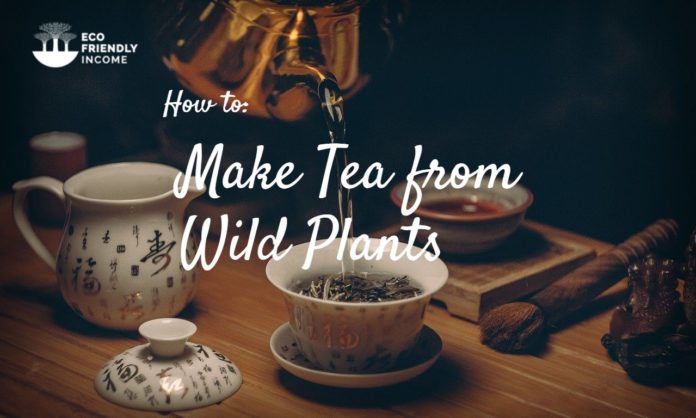Did you know there are wild tea species that grow naturally in North America? Not only is there wild tea, but there are also many other wild plants that make delicious tea, and most of them have medicinal properties!
Let me let you in on a secret: When you start to learn the plants of the forest, you open up a whole new world of tea.
Store-bought tea just doesn’t look the same anymore, the freshly picked leaves are just packed with flavors from which the likes you’ve never seen, or smelled before!
The cool thing with using wild plants to make tea is that you get to make your own recipes, you become a tea artist.
You can separate wild herbal tea crafting into 3 steps:
- First: You want to pick a tea base with a distinct flavor.
- Second: Add a fruity splash for flavor and antioxidants.
- Third: Add some healing plants to complete your elixir of life.
Now let me tell you about those special wild tea plants, so you can start your own wild tea ingredients list, here they are:
3 Staple Wild Herbal Tea Bases From the Boreal Forest
1. Labrador Tea
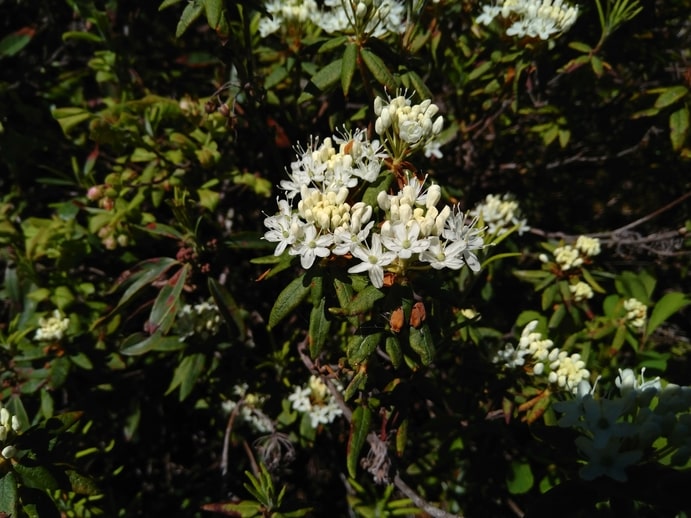
The flavor is unique on its own, you have to taste it to see! Personally, I love it. Labrador tea is also amongst the medicinal plants of the boreal forest. It helps relieve symptoms of the common cold, asthma, but the most surprising is that it helps control glucose levels in your blood, acting similarly to insulin!
Some say labrador tea has side effects when consumed in large quantities. From my experience, the potency of the tea is related to the area you picked it from, some areas will have a smooth taste while others a robust flavor.
FFor more info, check out: How to Identify & Propagate Labrador Tea.
2. Creeping Snowberry
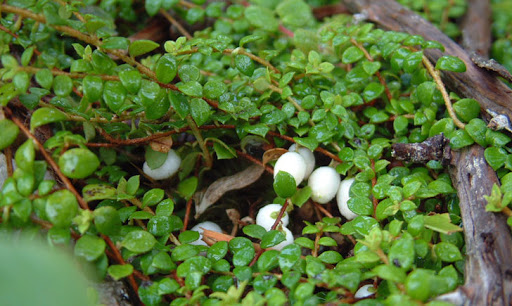
Creeping snowberry is a real treasure, steeping the leaves in a tea will extract its delicious minty flavor. Did you know the flavor in the little white fruits is the same that’s used in wintergreen gum? Yummy.
This along with wintergreen is your best ally to splash a taste of wild mint into your tea mixes.
As a matter of fact, creeping snowberry is a great headache relieving tea.
For more info, check out: How to Identify Creeping Snowberry.
3. Eastern Teaberry
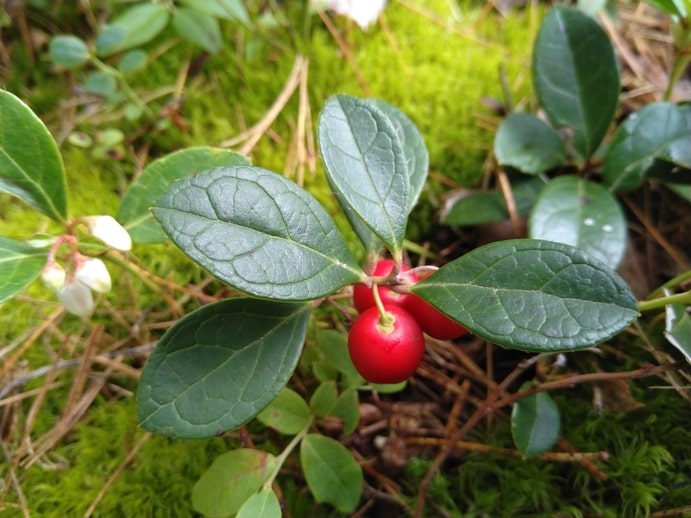
Just like Creeping Snowberry, eastern Teaberry has a delicious minty flavor, but even stronger! The aroma this plant gives off while you steep it is just amazing.
Teaberry leaves contain an aspirin-like chemical that helps reduce pain, swelling, and fever. Therefore it’s one of your best ingredients should you make a headache relieving tea.
For more info, check out: How to Identify Wintergreen.
Recap: The Trifecta of Wild Northern Tea
- Labrador Tea
- Creeping Snowberry
- Eastern Teaberry
You could call the 3 teas above the trifecta of wild teas because they are the most well-known northern herbs you can pick in the wild that are great tea bases. Labrador tea and creeping snowberry are largely abundant and often grow together, while eastern teaberry is rarer and tends to grow in small patches.
1 Alternate Wild Tea Base with Incredible Properties
Chaga
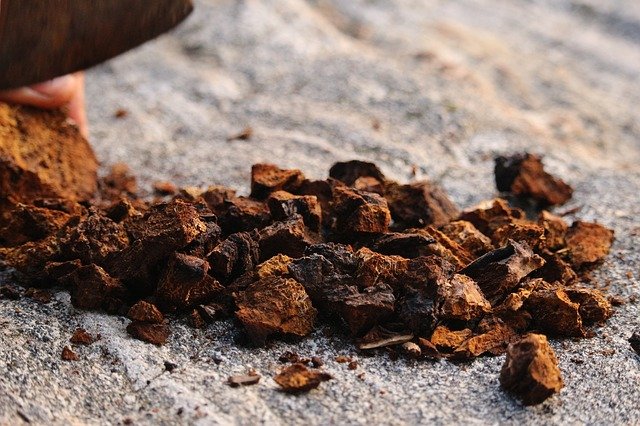
Chaga is not a plant but a mushroom! It grows on birch trees, like a parasite but takes a large variety of nutrients and vitamins from the tree. For this reason, Chaga mushrooms contain an astounding amount of medicinal properties, as a matter of fact, it’s one of the powerhouses of medicinal forest products.
What I do is use the fine side of a cheese grater to grind the Chaga clumps down to a powder, then I add this powder into a tea strainer and let it steep for a minimum of 10 mins in steaming hot water. This will give it enough time to pull all the amazing properties out of the Chaga.
After 10 mins, I remove the strainer and drink it without adding anything. I like the earthy, woody flavor it has but adding a spoonful of honey is not a bad idea either.
Since Chaga is alkaline, it’s a great base to neutralize acidity in your fruity teas. And the soft, earthy flavor makes it a great base for any other types of tea combinations you might make.
Editor’s Choice Wild Tea Base
Blueberry Leaves
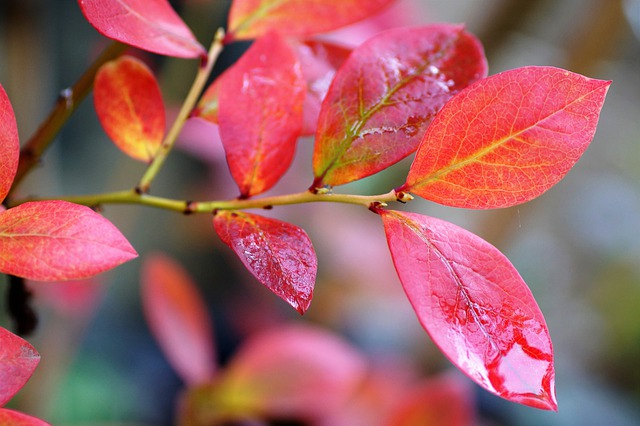
Normally blueberry leaves are green, but the best time to pick them at the end of summer or during autumn, when the leaves turn red.
This is when you will benefit the most from their rich antioxidant properties and harm the plant the least. Did you know the leaves actually have more antioxidants than the berries?
Blueberry leaves have a fine note of blueberry, but also a tinge of greenery and flower. They are a great base for acidic teas, that are balanced with alkaline herbs.
Blueberry leaves are a great base for immune boosting, anti-aging herbal teas.
For more info, check out: Wild Blueberries: Identification & Propagation Guide.
5 Northern Berries That Add a Fruity Splash to Your Wild Herbal Tea
While the tea bases above have smooth flavors, we might want to add a fruity splash to them to enhances the explosion of flavor happening with every sip.
There are many berries found growing in the northern forests with delicious properties that make them perfect addition to any teas, some you might know, others you might never have heard of them!
Generally, if you want to extract the most flavor, you will want to pick these fruits and let them dehydrate first to better preserve them. Dehydrating them will also increase their sweetness!
Pro tip: Some of these berries, like blueberry, for example, will dry much faster if you poke a hole in them with a toothpick.
Having a dehydrator helps a whole lot in drying them too.
1. Blueberry
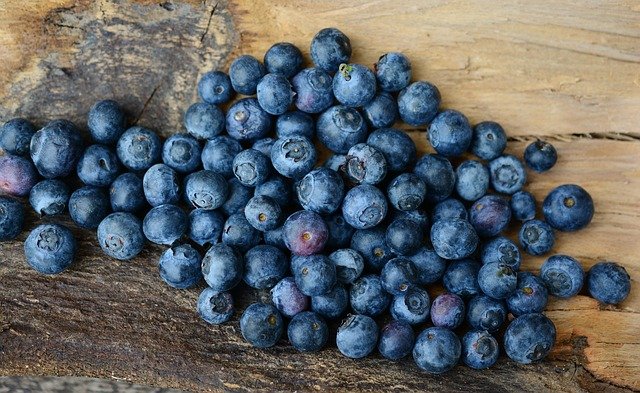
You can always go buy store-bought blueberry for this but I highly recommend picking wild ones. The store-bought options often come from far away, which doesn’t make it so eco-friendly but also doesn’t have the same flavor.
If you’ve ever had wild blueberries, you know they pop in flavor! This is why I highly recommend them, as for me, they are my personal favorite. Blueberry anything? I’ll eat it!
Blueberries are super rich in anti-oxidants, which is a secret ingredient to offset aging. They also contain other powerful vitamins like K1, C, and minerals like manganese.
Check out the varieties of wild blueberries you can pick yourself.
2. Raspberry
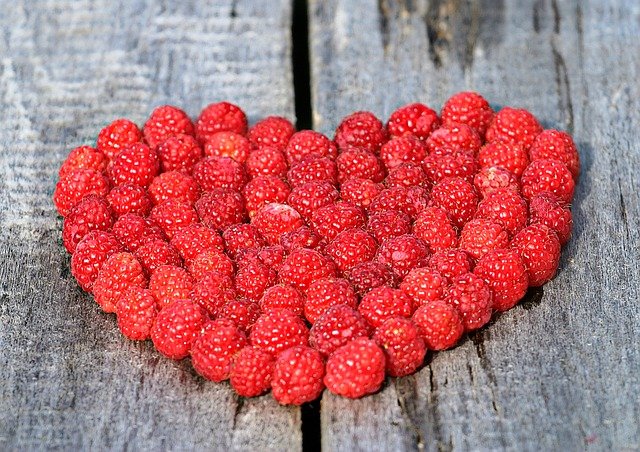
Raspberries are a beloved berry, that is so powerful in flavor. It’s an amazing addition to your wild tea to REALLY make it pop.
You can buy them at the store or pick them in the wild, either way you must get your hands on them.
Drying them is best done in a dehydrator and will really preserve the powerful flavor in this berry.
Raspberries are another berry that will add a sweet combination of vitamins into your wild tea, goodies such as Vitamin A, thiamine, riboflavin, vitamin B6, calcium, and zinc. You can’t let this one slide!
3. Wild Cranberries
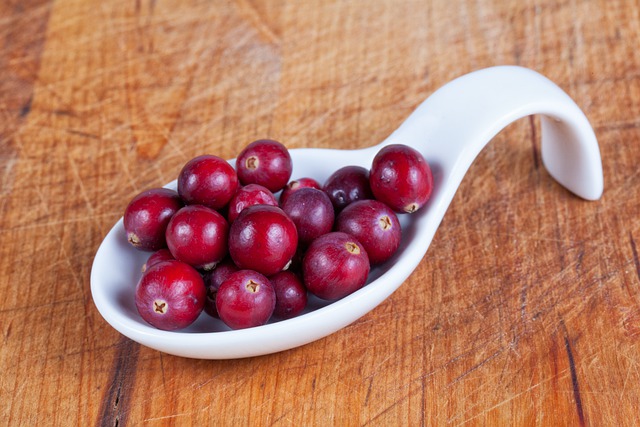
Wild Cranberries! Have you ever seen any? It’s a new-found wild plant for me this year. I hadn’t even thought about them growing in the wild, but they do, and wow! The flavor!
I had gone out for a walk in the woods to spot anything interesting and I see some red dots along with the moss, upon closer inspection I find out they are berries, and looking at the leaves, I just knew what they were. Wild cranberries!
I picked one and promptly tasted it, it kind of popped in my mouth but then unleashed a wave of juicy, sweet, and sour flavor. Mmmmm, now that was something.
Cranberries are known for clearing up your system, especially the urinary tract. Adding these to your tea will add some detoxifying properties.
Wild cranberries have a range of nutrients like vitamin C, E, K1, and minerals like manganese and zinc.
For more info, check out: How to Identify Wild Cranberry.
4. Wild Strawberries
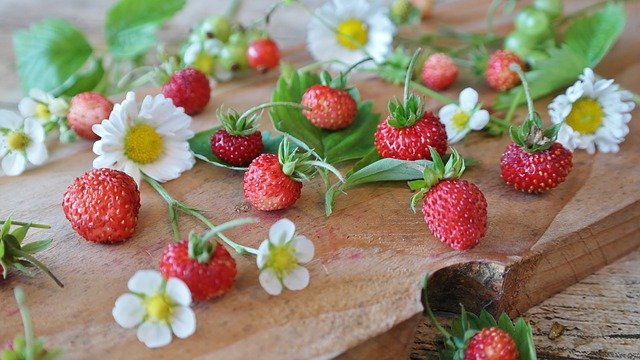
I have fond memories of picking these little wild strawberries from the fields at my grandfather’s house back in the day. You can’t match the flavor of this small variety that grows in the wild!
These make seriously delicious jams but drying them and adding them to your wild tea mix isn’t something you will regret.
The best way to go about it is to grind them up first and let them dry in small pieces in your dehydrator. You will just love the smell these will give to your tea.
These little jewels are also packed in nutrients like vitamins A, C, E, and the B-complex group as well as minerals such as potassium, manganese, fluorine, copper, iron, and iodine
5. Juniper Berries
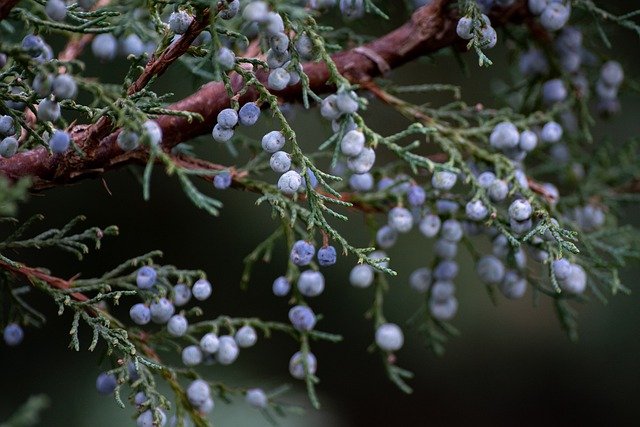
Juniper Berry you say? Yes I mean it. If you have tried gin before, then you know about the taste of juniper berries!
You won’t see them at the stores, that’s for sure so your only option is the pick them, but it will be worth your while.
Juniper berries have a unique flavor, you can taste the piney aroma but it also has a slight touch of fruitiness and pepperiness.
Juniper berries also have important nutrients such as vitamin C, flavonoid antioxidants, monoterpenes, and coumarins, which has secret properties that fight early onset of cancer!
13 Healing Plants that Transform Your Wild Tea into an Elixir
The last aspect when combining your tea ingredients is the healing herbs, these have less of an inclination towards flavor and more of an inclination towards medicinal properties.
Finding the perfect combinations and quantities is really an art. I have suggestions to offer but what works for me, might not work for you.
Drinking hot tea is beneficial in so many ways when you add in medicinal herbs. You can make combinations that fight colds, others that improve concentration, and some that are just daily brews to boost the immune system. Generally, drinking lots of liquids will keep your skin healthy, but if it’s tea then the benefits are amplified.
1. Spruce Needles
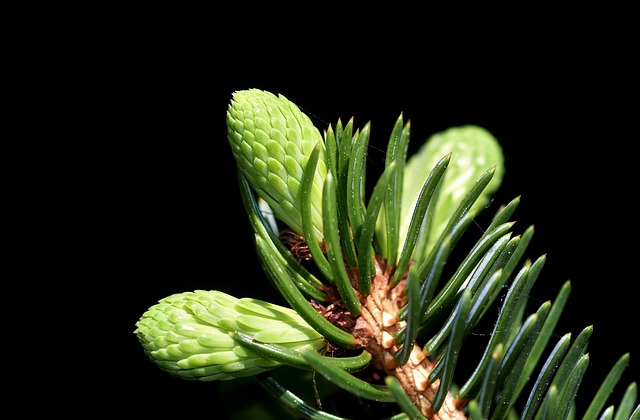
Young spruce needles have a light lemony flavor while older needles harvested during winter yield a stronger spruce taste. These won’t influence the taste of your tea much, what we are adding this in for is the immune-boosting properties of spruce.
Spruce needles, along with other parts like the cones, have properties to fight common colds and influenza.
It’s a great addition to a herbal tea mix specifically made to drink when you are coughing or having problems with your respiratory tract.
2. Willow Bark
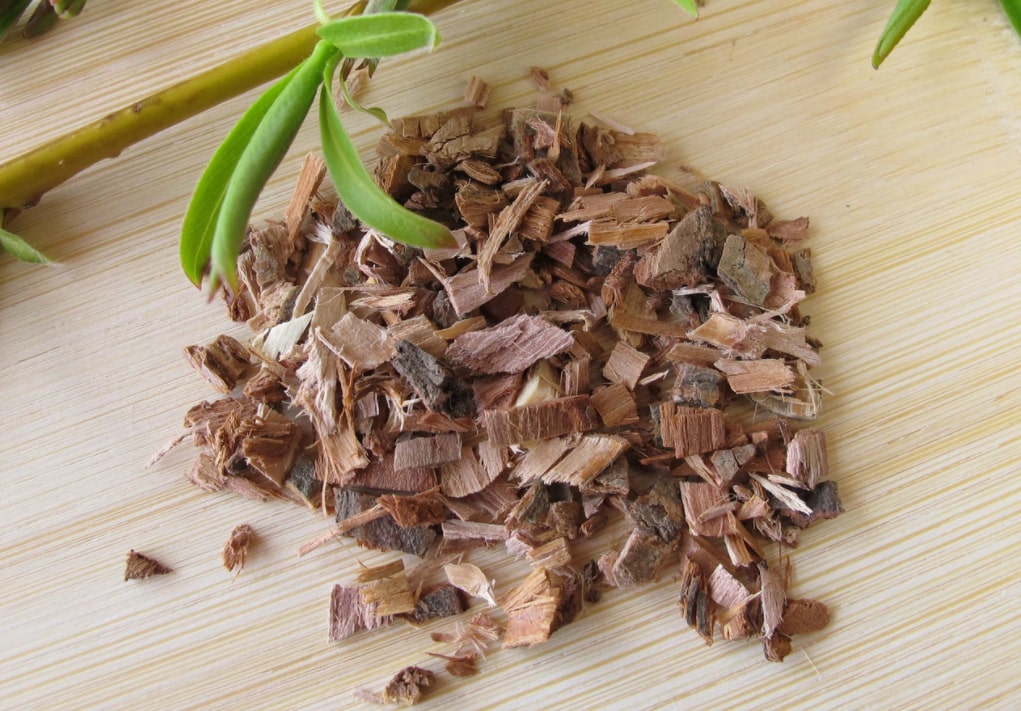
Willow bark has a pleasant, earthy aroma to it. Fresh barks will have a bitter taste but that’s just the medicine within! Add some honey to easily overcome the bitterness.
Willow bark has pain relieving qualities, it’s actually what aspirin was made from!
Adding this to your tea will turn it into an ideal candidate for treating headaches and muscle aches.
3. Eastern White Cedar
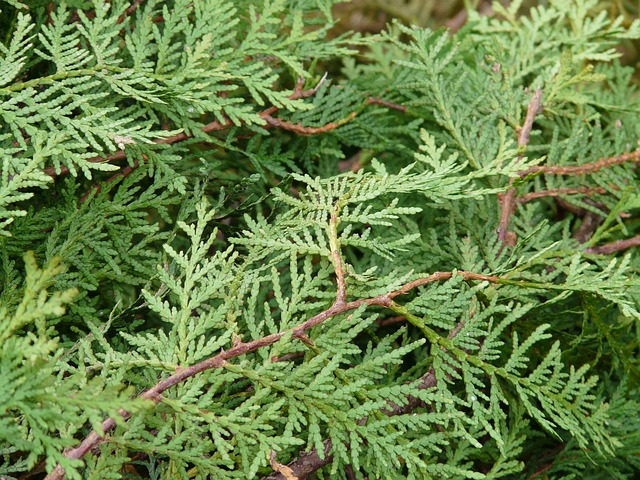
Thuja has a distinct aromatic flavor that’s worth adding to your tea, it’ll remind you of camping nights, bonfires, and the fresh outdoors.
Thuja is good for respiratory infections, and most importantly skin problems. Drinking tea with thuja in it will help heal cold sores. Eastern White Cedar has a moderate amount of vitamin C.
4. Pearly Everlasting
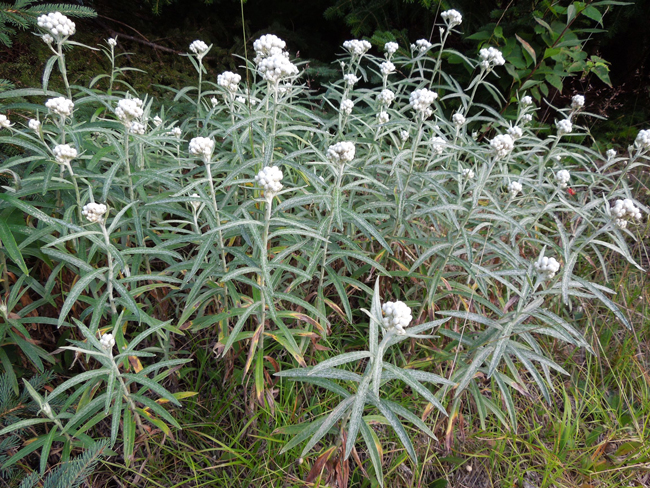
Pearly everlasting is a great flower to add to your teas, it has a smooth flavor is a bit grassy but hardly noticeable.
The greatest thing about the leaves is their expectorant properties, when you are plugged with mucus and your nose is stuffy, this magical plant does an amazing job unclogging everything.
From experience, I’ve used this every time with great effect. Within 10 mins, my sinuses were cleared and I could blow my nose very easily and start breathing again! I highly recommend adding pearly everlasting into tea blends to use when you are sick.
5. Canada Goldenrod
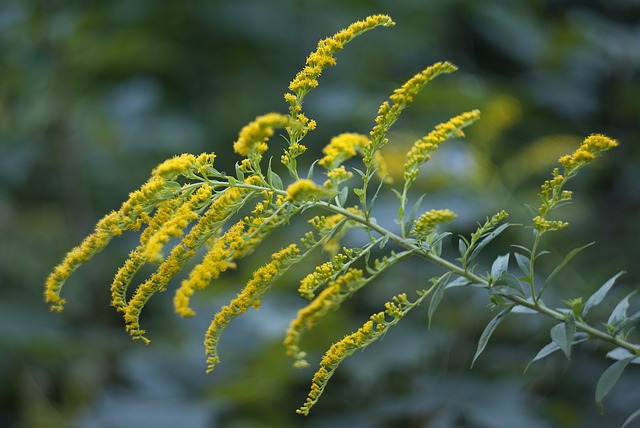
The floral flavor of Canada Goldenrod can add a nice touch to your wild herbal tea. The flowers have a sweet “anise-like” scent that gives it its flavor.
The great medicinal property of Canada Goldenrod is its ability to treat hypertension. It’s a great addition to your teas aimed at relaxing your body and mind.
You can also add goldenrod to your tea to help treat seasonal allergies.
6. Sweetfern
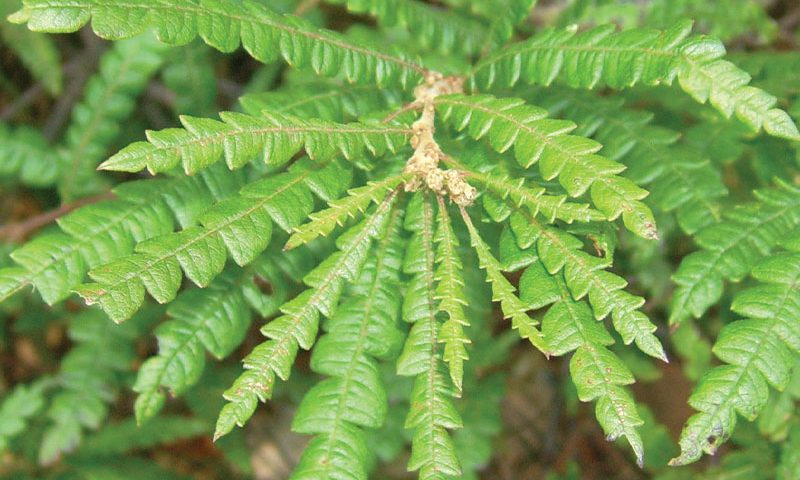
Sweetfern is an aromatic plant, although it’s delicate to brew, the flavor is quite good. Brewed at the right temperature, it offers a robust flavor similar to black tea.
It’s great to add into a tea to treat rheumatic conditions, but its best property is to open energy channels and bring you a mental and physical boost of energy.
7. Common Plantain
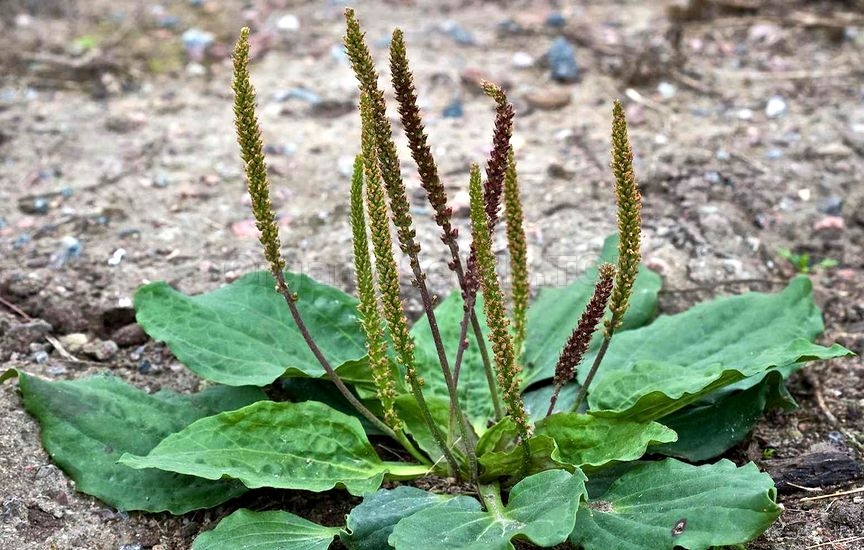
Plantain leaves make for a great tea even by itself, the flavor is somewhat earthy, yet slightly fruity.
Adding plantain to your herbal tea will give it properties to heal your digestive and urinary tract. It’s great for detox wild herbal blends.
It also acts as an expectorant to smooth inflamed and sore sinuses/throat.
8. Stinging Nettle
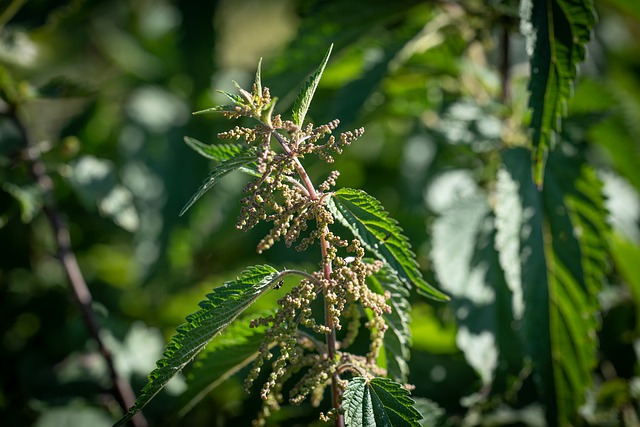
Stinging Nettle has a familiar flavor, you could say it’s a rich, earthy version of seaweed.
This medicinal plant is actually one of the powerhouses of herbal medicine.
Use the leaves in your herbal tea to treat inflammation, treat enlarged prostate, and fever. It can lower blood pressure, regulate blood sugars, and help liver problems.
9. Red Clover
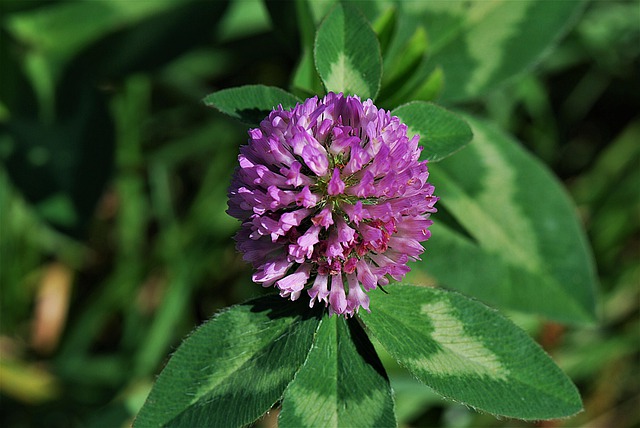
Red clover is another great medicinal plant to add to your wild herbal tea blends. The flavor is mild and earthy with a sweet pea-like taste.
The leaves and flowers are nutritive, with many minerals, and have great properties to deal with menopausal symptoms.
Due to its nutritive value, its great to add to a health fortifying wild herbal tea blend.
10. Wild Rose
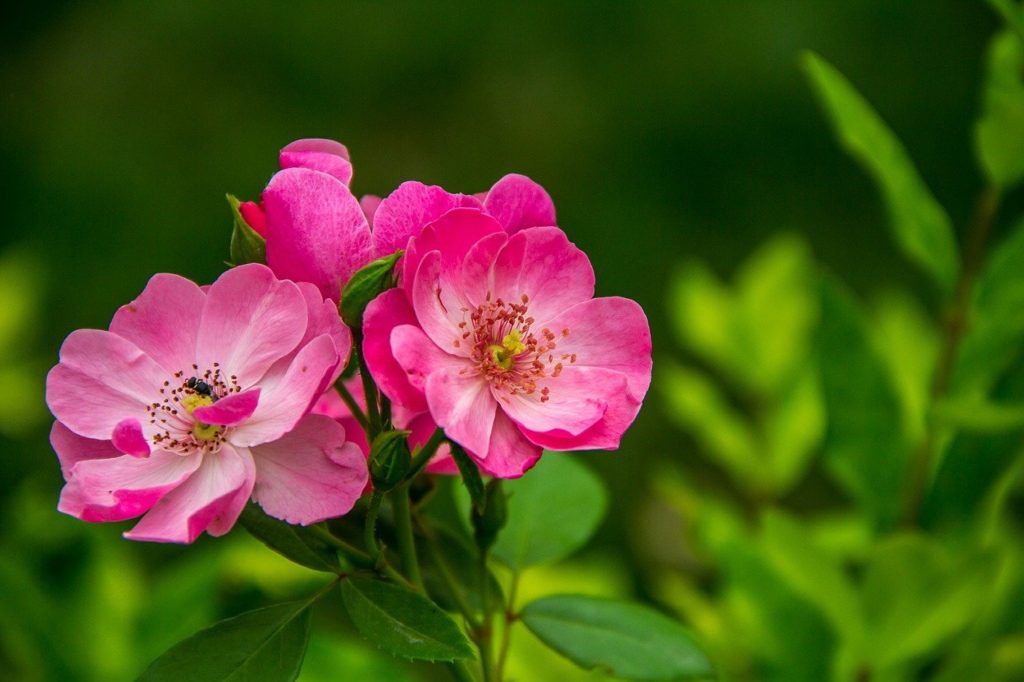
Do I have to say why I added wild rose to the list? I don’t think anyone would disagree with putting wild roses into their herbal tea blends. The fragrance of the rose transfers to the flavor of the tea, it’s wonderful.
Wild rose is a tonic, therefore it will invigorate and strengthen your system.
It’s great to relieve stomach and digestive problems, to improve sleep, reduce irritability and mood swings, to relieve menstrual cramps and menopausal symptoms.
11. Raspberry Leaves
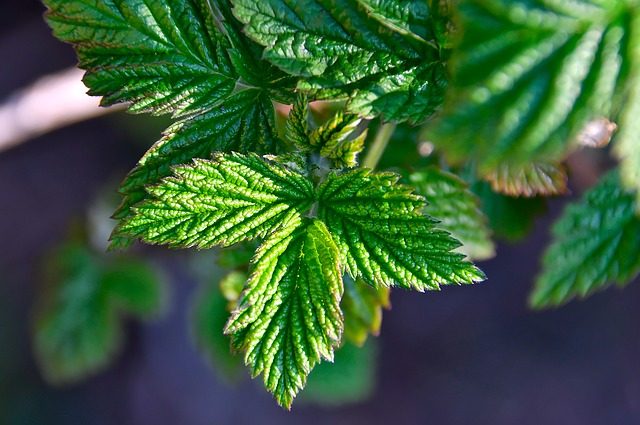
Not only the fruit is appealing for wild herbal tea, but also the leaves! Raspberry leaves have a mild flavor similar to green tea that makes it a great addition to any tea, it could even be a tea base.
The strongest medicinal property of raspberry leaves is their ability to regulate the female reproductive system. It’s one of the best herbs to relieve the symptoms of PMS, endometriosis, pregnancy, and menopause.
Raspberry leaves also contain polyphenols like tannins and flavonoids, therefore they act as an antioxidant in your body and can help protect cells from damage.
12. Common Yarrow
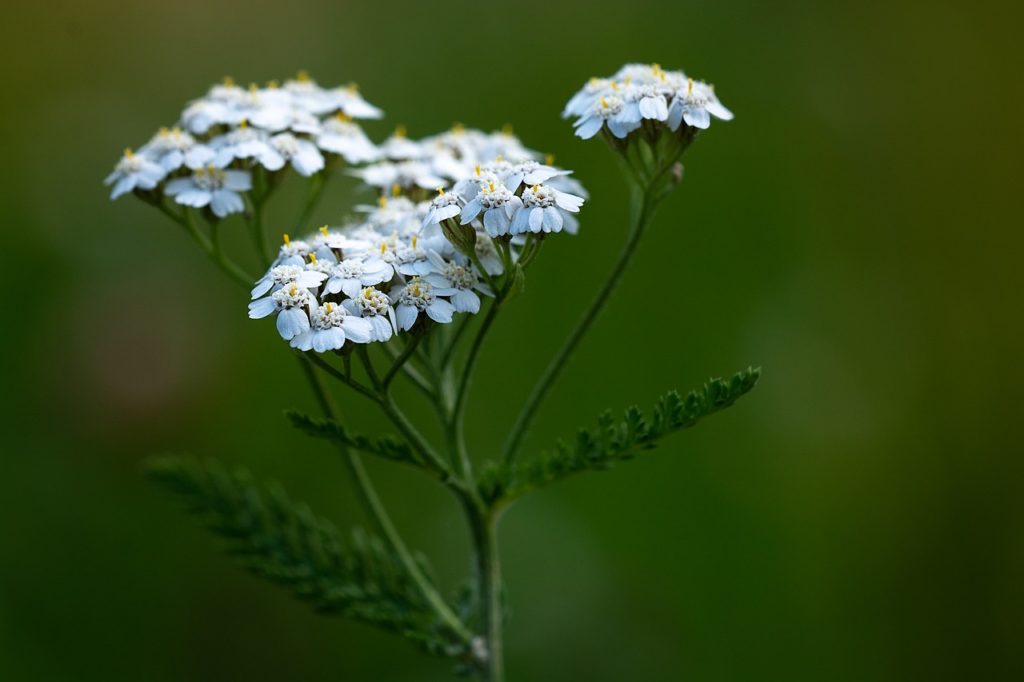
Yarrow has a bitter taste but can be neutralized by adding honey or maple syrup.
It contains powerful bactericides, which prove useful in reducing fever, relieving headaches, tooth aches, respiratory problems and common cold.
This is a perfect addition to a wild herbal tea blend that helps relieve any sort of pain, especially headaches and toothaches.
13. Wild Chamomile
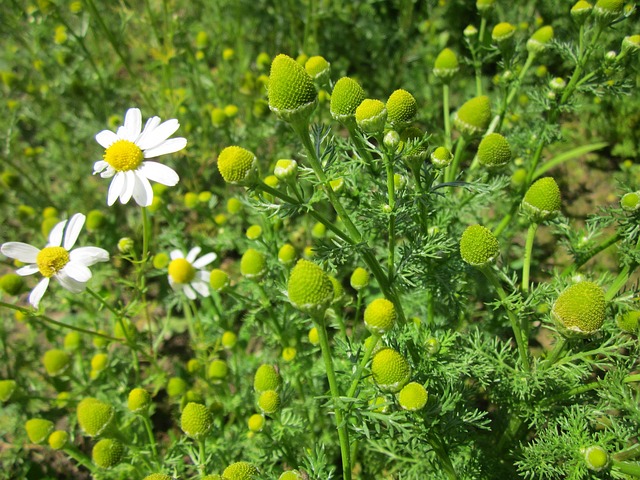
Chamomile is a well-known herb, it’s good enough to be a staple tea on its own. It has a smooth flowery flavor that adds a great aroma to any tea blend.
Chamomile is a mild sedative, therefore it’s useful to relieve nervous tension, irritability, and digestive problems.
I would add mild chamomile to your herbal tea blend to drink before heading to bed, you’ll be sure to have good sleep.
The secret to brewing delicious wild tea
Putting the ingredients together is easy, finding the perfect recipe is hard. Above all, the secret is to combine acidity with alkalinity, and then to add a hint of fruit. For instance, tea that is too acidic will hurt your teeth, not only that but it will throw off the chemistry within your body.
You won’t know it, but too much acidity will put pressure on your kidneys, liver, and lungs then it might leave your body vulnerable to disease.
One of the reasons why water is so good for you is because it’s neutral. Therefore, you want to make your tea blend as close to neutral as possible and then add delicious flavors. This is what will genuinely turn your tea into an elixir.
Another important factor is the brewing temperature and time.
- You want to brew the herbal tea long enough, generally 5-10 mins for all the minerals, antioxidants and vitamins to be extracted.
- But you don’t want to brew it at too high of a temperature because it will actually destroy many of the benefits found within your tea. Herbals teas brewing temperature is right from 95 to 100 degrees Celsius.
How to Prepare Freshly Picked Leaves
After the tea is picked, it needs to be dried because if you don’t dry it quickly, it will start to grow mold and decompose. For something you plan to drink, this is especially important.
Firstly, a good way to dry them is to spread them on a container and leave them out in the sun. Although be warned, not every herb should be dried in the sun, and especially not if the sun is too hot because it might bleach them.
Secondly, if you are concerned about bleaching, tie them together in a bundle and hand them up upside down away from the sun, in a cool, dry place.
From my experience, it can take from 3 days to a week to dry. So it’s not a bad idea to cover the tea with a net to avoid dirt and bugs from getting in.
Personally, I prefer to keep the leaves on a branch instead of picking them apart and crushing them, this way it’s easy to steep.
Packaging
If you’d like to package them in tea bags then grinding is the way to go. If not, a good idea is to put the leaves in a tin can or a glass bottle to preserve the freshness.
Paper stand-up pouches are also great to put your tea in and you can find completely biodegradable ones selling online.
We hope this inspires you to make delicious wild herbal teas! Brewing these northern ingredients will surely bring your soul to the wild boreal forests of the north. May you make the best of elixirs.
If you want to know more details on how to find these plants in the wild, check out: Boreal Forest Medicinal Plants: The Illustrated Foraging Guide.
Happy pickins’!


